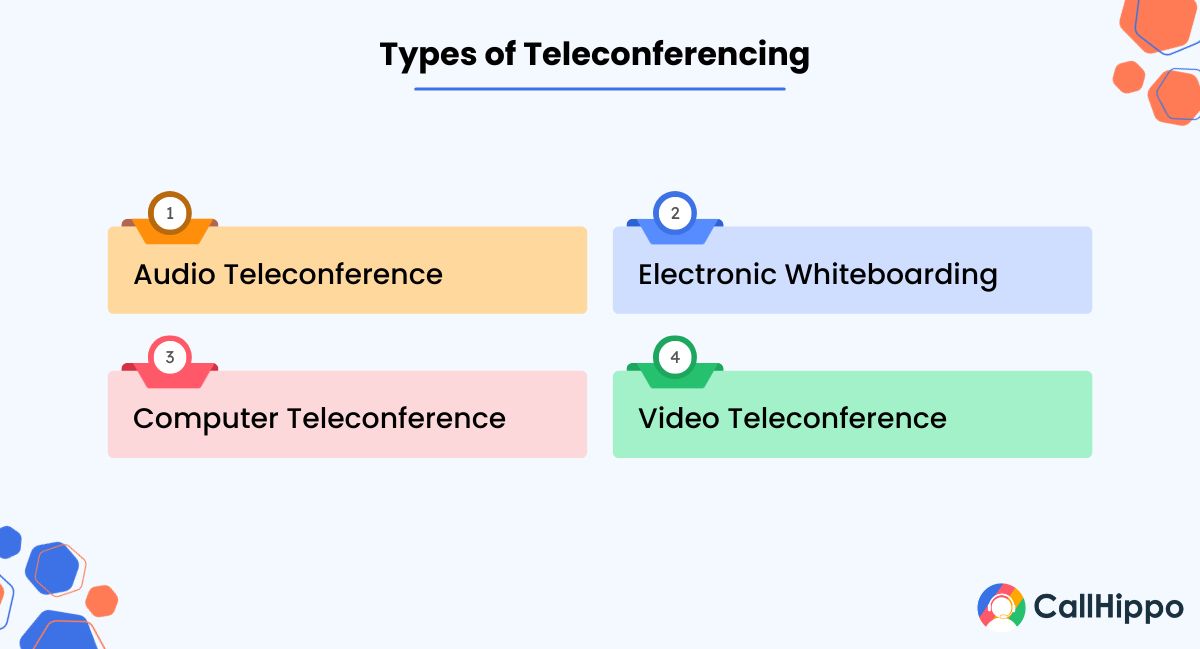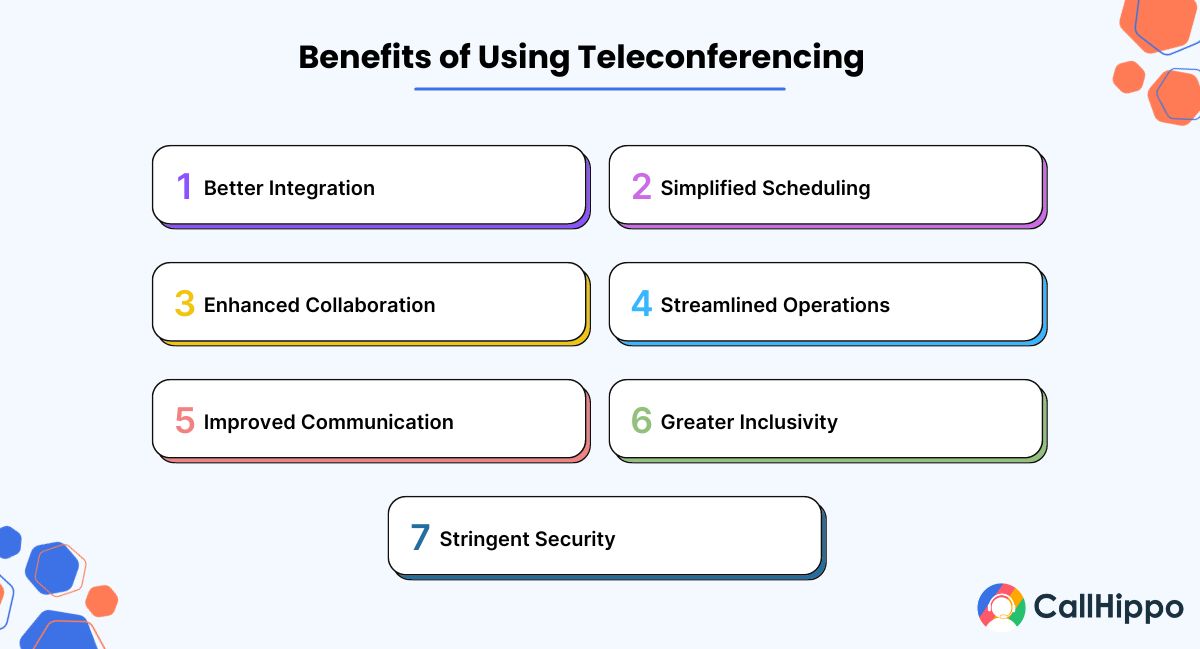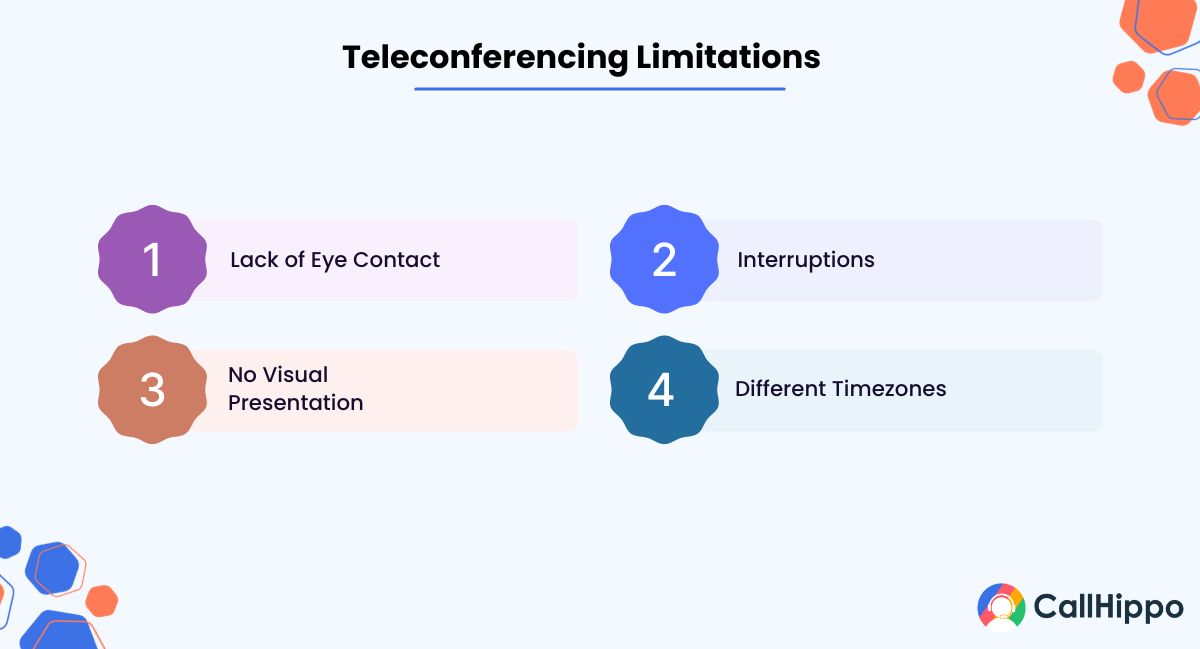In today’s digitized globe, teleconferencing is a total game-changer. Whether you’re running a business or are just trying to connect with people, this technology has emerged as the cornerstone of efficient communication. This technology is at the vanguard of this change in how we communicate and share information, which has taken place.
According to research, 76% of remote workers choose video conferencing as an essential component of their business. Teleconferencing, in its most basic form, gives us the ability to conduct meetings and discussions via technology, resulting in a virtual face-to-face encounter that transcends physical distance.
Meaningful discussions don’t have to take place in a closed-off space any longer. This adjustment is more than a convenience; it signifies a paradigm shift in how we approach meetings and discussions. In today’s blog, we’ll look at different sorts of teleconferencing services and their benefits. Let’s dig deep!
"Teleconferencing is a smart technology that can enhance operational efficiency. To improve the audio quality of teleconferences, present yourself professionally, keep distractions to a minimum, and wear headphones. Your trustworthiness will increase, and the overall quality of communication in remote meetings will be enhanced by a focused and professional appearance."
What Is Teleconferencing?
Teleconferencing is a modern communication tool that allows individuals or groups to participate in meetings, debates, or collaborations without physically being present in the same place. It uses technology to bridge geographical gaps through the use of audio and video channels for real-time contact.
Teleconferencing can range from simple voice calls to complex high-definition video conferences, and anyone with a phone or an internet connection can participate. This technology offers various advantages, including reduced travel and lodging costs, increased productivity, and improved cooperation among diverse teams.
Teleconferencing enables students to access remote instructional resources as well as maintain personal relationships by keeping families and friends connected across long distances.
How Does Teleconferencing Work?
Teleconferencing, or the process of communicating information between parties who are geographically separated, has progressed dramatically in recent years. Computer telephony, in particular, has transformed corporate users’ teleconferencing experiences.
Businesses can connect with hundreds of participants in conference calls using their corporate phone systems. These calls have a variety of functions, ranging from one-way information delivery to collaborative brainstorming sessions.
Dialing a specific phone number or accepting personal calls from an operator who links them over a conference call bridge (or audio bridge) are the two ways participants can join these sessions. This bridge serves as a server and is capable of managing numerous calls at once. For enhanced security, telecommunication systems might require callers to input login credentials and personal ID numbers.
Businesses either set up their own bridge or hire a phone service provider to host their conference calls as part of the teleconferencing process. These service providers frequently include a wide range of cutting-edge features for conference calling, including call recording and attendee polling.
Why Is Teleconferencing Important?
Teleconferencing is highly crucial since it can help you save extensive time, money, and resources. It makes it possible for people to interact without having to physically travel, making it an economical and effective option to set up meetings or discussions. This is especially helpful for businesses because it reduces costs while boosting output by cutting down on travel time.
The role it plays in reducing global disparities is another crucial aspect. Teleconferencing allows participants from all over the world to communicate in real-time, regardless of location. For international corporations, students studying abroad, and anybody wishing to stay in touch with far-flung family members, connectivity is essential.
Furthermore, teleconferencing improves during emergencies. It acts as a lifeline for communication during disasters, such as the COVID-19 epidemic, where actual gatherings were difficult. Teleconferencing guarantees that critical interactions can continue despite difficult circumstances, whether for urgent healthcare consultations, remote work, or emergency response coordination.
You May Also Read: 11 Best Video Conferencing Software in 2023
What Are the Types of Teleconferencing?
Teleconferencing has smoothly knitted itself into the fabric of modern communication in today’s technology-driven society. When you set up a conference call, you transcend geographical barriers while also improving collaboration and efficiency in both personal and business settings. There are various types of teleconferencing, each adapted to certain communication requirements.

Some of the most common ones include:
1. Audio Teleconference
The most fundamental form of teleconferencing is an audio conference call. It enables two or more people to communicate in real-time using voice over IP (VoIP) services over the Internet, mobile devices, or landlines. Audio teleconferencing is praised for being easily accessible and inexpensive. It is a cost-effective option for conference calls, project meetings, and team talks because it only needs simple tools like telephones. However, its potential for more dynamic and visually intensive engagements is constrained by the lack of visual components and document sharing.
2. Electronic Whiteboarding
Electronic whiteboarding teleconferencing boosts interaction by combining auditory communication with real-time graphic collaboration. Participants are given the ability to draw, write, or annotate on a digital whiteboard, which is accessible to all attendees. This teleconferencing method excels in situations requiring brainstorming, design talks, and instructive sessions. It helps to explain ideas and concepts more effectively by supplementing communication with visual components. Furthermore, electronic whiteboard applications frequently include functionality for screen sharing, document sharing, and text chat, making them adaptable options for both business and education.
3. Computer Teleconference
Computer teleconferencing merges audio, visual, and screen-sharing features on mobile devices. Through specialized software or web-based platforms, participants communicate in real time using their desktops or mobile devices. These teleconferences have a place in online meetings, webinars, and distance learning courses. They give participants an all-encompassing experience while enabling seamless eye contact, screen sharing, and multimedia discussion. Remote teams at businesses stand to benefit the most from computer teleconferencing’s strong resemblance to in-person meetings.
4. Video Teleconference
As far as communications technology is concerned, video teleconferencing is at its pinnacle. It combines high-definition audio, video, and screen sharing to create an unmatched communication experience. These conferences offer an excellent substitute for in-person meetings since participants can see and hear each other as if they were in the same room. Applications for video teleconferencing are many and include business meetings, doctor visits, educational initiatives, and even private family gatherings. The potential of non-verbal communication is harnessed by this format, which captures facial expressions and body language.
What Are The Benefits of Using Teleconferencing?
Teleconferencing has emerged as a key tool for both enterprises and individuals in an era when remote work and global collaborations have become the norm. This advanced communication technology bridges geographical gaps, offering numerous benefits that expedite operations and boost overall efficiency. Since you are clear about what teleconferencing is, it’s now time to look at some of the most common benefits of using teleconferencing.

These mainly include:
1. Better Integration
The key to creating seamless integration throughout enterprises is teleconferencing. It serves as the link between geographically separated teams, allowing them to collaborate as if they were in the same space. Employees from disparate places can take part in discussions, share ideas, and work together to overcome issues through video and voice communication. Real-time communication cuts over geographical barriers and social strata to promote cohesion and a feeling of purpose. Teleconferencing ensures global inclusion in the organizational ecosystem, from daily stand-up meetings to cross-functional collaborations.
2. Simplified Scheduling
Scheduling meetings and appointments used to be a time-consuming and logistically difficult task. Teleconferencing has simplified scheduling and so transformed this part of company communication. Travel time, airplane delays, and the availability of physical meeting locations are no longer factors to consider. Teleconferencing eliminates these difficulties, allowing meetings to be scheduled at the drop of a hat or weeks in advance. Time zone variations are easily controlled by using scheduling systems that take into account the desired time slots of participants, making it simple to coordinate people from all over the world.
3. Enhanced Collaboration
In today’s interconnected world, collaboration is the backbone of innovation and productivity. There are multiple uses of teleconferencing that enhance collaboration by offering a virtual space where team members can work together as if they were in a physical office. Features like screen sharing and document collaboration allow for real-time interaction, enabling employees to collectively brainstorm, analyze data, and troubleshoot issues. The virtual whiteboard, for instance, becomes a canvas for ideation, enabling creative brainstorming sessions and strategic planning. Virtual collaboration empowers efficient teamwork, regardless of location, a cornerstone for businesses with cross-functional teams, brainstorming, and projects.
4. Streamlined Operations
Numerous parts of corporate operations are considerably streamlined via teleconferencing. The cost reductions are clear when businesses cut back on, or perhaps do away with, costs for travel, lodging, and office space. Both time and money are saved by eliminating the need for staff to physically travel to meetings. This results in quicker decision-making and more effective utilization of resources. The benefits of teleconferencing also include a decrease in the administrative effort required to plan in-person meetings, arrange catering, and reserve physical facilities.
5. Improved Communication
Every successful firm relies on effective communication. Teleconferencing has redefined communication parameters, guaranteeing that every message is transmitted clearly. It reduces the possibility of misinterpretation and encourages a deeper grasp of the subject matter by using high-definition audio and visual quality. Furthermore, the ability to record meetings ensures that information and decisions are preserved for future use. This is extremely useful for training, compliance, and knowledge preservation.
6. Greater Inclusivity
Teleconferencing is essential for fostering diversity in workplaces. It gives a helping hand to all employees, no matter where they are located or how they are physically. Due to the fact that they may actively participate in conversations, decision-making, and collaborations, remote workers are no longer at a disadvantage in terms of participation. The company’s operations and culture are fully integrated into satellite offices. People with physical restrictions or disabilities that could prevent them from attending in person can participate in teleconferences.
7. Stringent Security
In an era where data security is a paramount concern, teleconferencing provides an added layer of protection. Reputable conferencing platforms prioritize the security of sensitive information. Features such as end-to-end encryption, password protection, and secure data transmission ensure that confidential conversations and shared documents remain private and secure. This reassurance is essential for organizations in sectors like healthcare, finance, and legal services, where data confidentiality and privacy are non-negotiable.
Don’t Miss To Read: Top 13 Best Conference Call Service For Business in 2023
What Are The Limitations of Teleconferencing?
Teleconferencing, which includes both video, audio, and web conferences, has become a crucial tool for communication and collaboration. It does, however, have its own set of obstacles and restrictions.

These primarily include:
1. Lack of Eye Contact
Teleconferencing, a valuable modern communication tool, does have a drawback in the form of limited eye contact. In traditional face-to-face meetings, making eye contact builds trust and connections. However, during teleconferencing, people often look at screens or multitask, which can reduce engagement and make it challenging to understand others’ feelings and reactions. This can hinder effective communication because body language cues are limited. To improve virtual meetings, prioritize eye contact and effective camera positioning for better engagement and connection. These small adjustments can significantly improve the quality of your online communication.
2. Interruptions
Teleconferencing, despite its ease, is susceptible to disturbances. Technical concerns, such as bad internet connections or audio glitches, can cause participants to drop out or miss important information. Background noise from diverse contexts, such as pets or household activities, can also disrupt talks, resulting in dissatisfaction and decreased productivity. To avoid interruptions, participants should maintain a solid internet connection and reduce background noise. To avoid disruptions, hosts can set criteria for muting when not speaking and using chat functions.
3. No Visual Presentation
Teleconferences sometimes lack the clarity that tangible aids such as whiteboards or props provide in-person discussions. Even while screen sharing allows you to share slides and documents, it may not necessarily have the same impact. One solution is to use AI presentation tools that enhance sessions with features such as smart annotations, live feedback, and voice-assisted slide transitions.
In many cases, support teams also create videos with an AI video generator to make complex topics easier to explain during calls. When combined with digital whiteboards, these technologies enable presenters to communicate concepts more effectively and keep the audience engaged. To make things go more smoothly, distribute crucial documents ahead of time so that everyone can easily follow along.
4. Different Timezones
Teleconferencing allows for global communication, but coordinating meetings across time zones can be difficult. Participants may be required to attend meetings outside of normal working hours, which may result in fatigue and decreased interest. As communication becomes asynchronous due to time zone differences, decision-making processes might be slowed. To address this issue, teams should set regular meeting times that are as accommodating to everyone as feasible, rotate meeting schedules to disperse the burden, and consider using scheduling systems that display several time zones.
You May Also Like To Read: How To Set Up A Conference Call? [6 Easy Steps]
Conclusion
Teleconferencing can take many forms, from simple voice calls to high-definition video conferences done through suitable software. Despite its limitations, teleconferencing is nevertheless essential for effective communication and connectivity in an interconnected world. Addressing these issues will increase its effectiveness, making it a necessary tool for modern living and working.
FAQs
1. What Is Teleconferencing in Business Communication?
Teleconferencing in business communication is the technique of holding meetings and conversations with remote participants using audio and visual technology in corporate communication. Businesses may now support real-time communication and cooperation among employees, partners, and clients regardless of their physical location.
2. What Is a Teleconference Meeting?
A virtual meeting where people from many locations connect via communication technology is referred to as a teleconference. This can involve video conferences or audio-only calls that enable people to communicate and exchange information without being physically present. Teleconference meetings are practical and economical, fostering productive and adaptable communication in professional contexts.
3. How Can Businesses Ensure Security During Teleconferences?
For organizations, ensuring security during teleconferences is critical. To do so, they should follow a cybersecurity checklist that includes using encrypted communication platforms, strict access controls, secure login credentials, and educating participants on cybersecurity best practices. Regular software updates and monitoring for potential security breaches can protect sensitive information and ensure the integrity of teleconference meetings.
4. What Are Some Popular Platforms for Teleconferencing?
In the professional sector, teleconferencing is done using a number of well-known platforms. These include Cisco Webex, Microsoft Teams, Zoom, and Skype. These platforms provide tools for remote business communication, enhancing the ability to hold meetings, presentations, and discussions with geographically dispersed teams and clients, such as screen sharing, audio and video conferencing, and document collaboration.

Subscribe to our newsletter & never miss our latest news and promotions.









